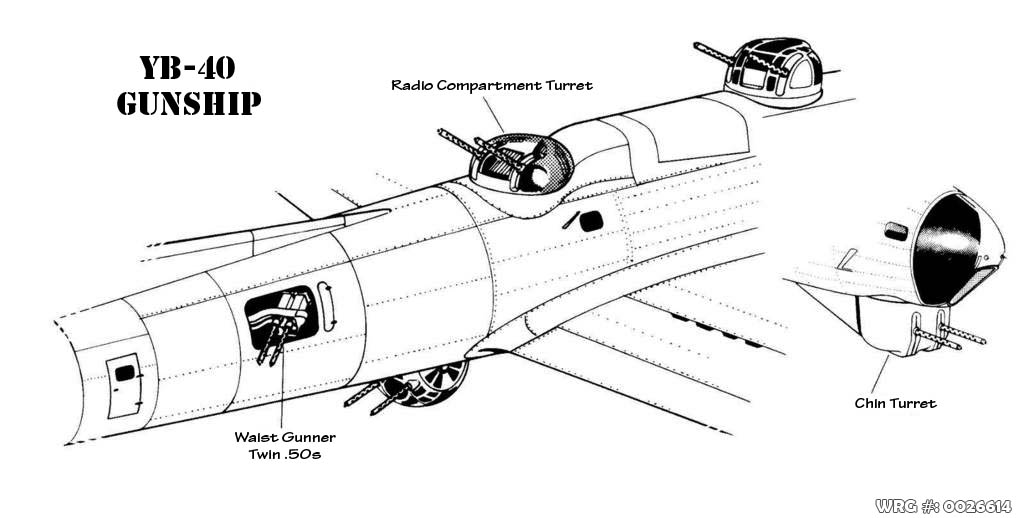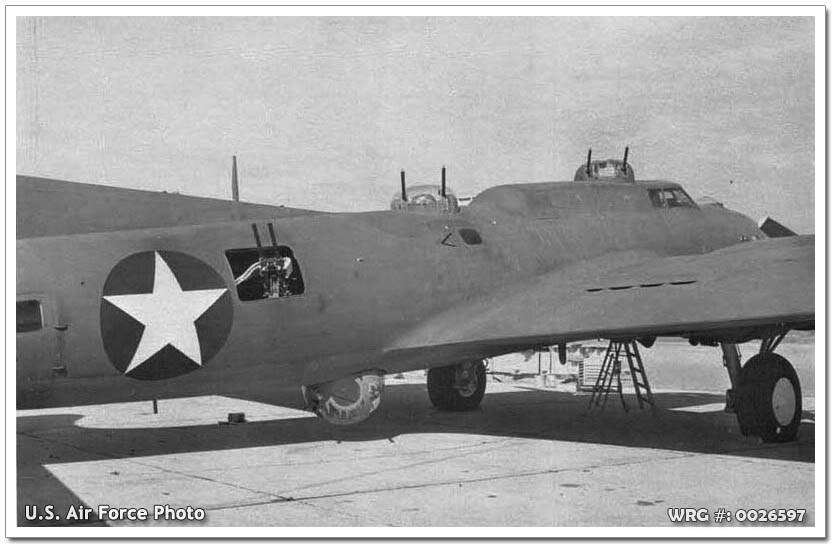U.S.A.A.F. RESOURCE CENTER > BOMBERS > FLYING FORTRESS > VARIANTS > PREVIOUS PAGE
Variants - YB-40
Design and Development
Work on the prototype, Project V-139, began in September, 1942 by converting the second production B-17F-1-BO (serial number 41-24341) built. Conversion work was done by Lockheed's Vega company.

YB-40 Flying Fortress/41-24341.
[Source: USAF Photo]

The aircraft's gross weight was some 4,000 lb (1,800 kg) greater than a fully armed B-17. An indication of the burden this placed on the YB-40 is that while the B-17F on which it was based was rated to climb to 20,000 ft in 25 minutes, the YB-40 was rated at 48 minutes. Part of the decreased performance was due to the weight increase, and part was due to the greater aerodynamic drag of the gun stations.

YB-40 Flying Fortress.
[Source: USAF Photo]
Because Vega had higher priority production projects, the YB-40/TB-40 assembly job was transferred to Douglas. A variety of different armament configurations was tried. Some YB-40s were fitted with four-gun nose and tail turrets. Some carried cannon of up to 40 mm in caliber, and a few carried up to as many as 30 guns of various calibers in multiple hand-held positions in the waist as well as in additional power turrets above and below the fuselage.
Externally, the XB-40 had the symmetrical waist windows of the standard B-17F and the second dorsal turret integrated into a dorsal fairing. In contrast, most of the YB-40s had the positions of the waist windows staggered for better freedom of movement for the waist gunners, and the aft dorsal turret was moved slightly backwards so that it stood clear of the dorsal fairing.
Operational history
The YB-40's mission was to provide a heavily gunned escort capable of accompanying bombers all the way to the target and back. Of the initial order of 13, one (43-5732) was lost on the delivery flight from Iceland to UK in May 1943; it force-landed in a peat bog on an offshore Scottish island after running out of fuel. Although removed to Stornoway and repaired, it never flew in combat. The remaining 12 were allocated to the 92d Bombardment Group (Heavy), being assigned to the 327th Bombardment Squadron, stationed at RAF Alconbury (AAF-102) on 8 May 1943.
YB-40s flew in the following operational missions:
| May 29, 1943 - | Attacked submarine pens and locks at Saint-Nazaire. Smaller strikes were made at Rennes naval depot and U-boat yards at La Pallice. In the attack, seven YB-40s were dispatched to Saint-Nazaire; they were unable to keep up with B-17s on their return from the target and modification of the waist and tail gun feeds and ammunition supplies was found to be needed. The YB-40s were sent to Technical Service Command at the Abbots Ripton 2nd Strategic Air Depot for modifications. |
| June 15, 1943 - | four YB-40s were dispatched from Alconbury in a raid on Le Mans after completion of additional modifications. |
| June 22, 1943 - | Attack on the I.G. Farben Industrie Chemische Werke synthetic rubber plant at Hüls. The plant, representing a large percentage of the Germany's synthetic rubber producing capacity, was severely damaged. In the raid, 11 YB-40s were dispatched; aircraft 42-5735 was lost, being first damaged by flak and later shot down by Uffz. Bernhard Kunze in a Focke-Wulf Fw 190A-2 of JG 1 over Pont, Germany. The 10 crew members survived and were taken prisoner. |
| June 25, 1943 - | Attack on Blohm & Voss sub shops at Oldenburg. This was the secondary target, as the primary at Hamburg was obscured by clouds. In this raid, seven YB-40s were dispatched, of which two aborted. Two German aircraft were claimed as destroyed. |
| June 26, 1943 - | Scheduled but aborted participation in attack on the Luftwaffe air depot at Villacoublay, France (primary target) and also the Luftwaffe airfield at Poissy, France. The five YB-40s assigned to the attack were unable to form up with the bombing squadron, and returned to base. |
| June 28, 1943 - | Attack on the U-boat pens at Saint-Nazaire. In the raid, the only serviceable lock entrance to the pens was destroyed. In this attack, six YB-40s were dispatched, and one German aircraft was claimed as destroyed. |
| June 29, 1943 - | Scheduled participation in attack on the Luftwaffe air depot at Villacoublay, but aircraft returned to Alconbury due to clouds obscuring the target. In the raid, two YB-40s dispatched, one aborted. |
| July 3, 1943 - | Attacks on aircraft factories at Nantes and Le Mans, France. In these raids, two YB-40s were dispatched to Nantes and one to Le Mans. |
| July 10, 1943 - | Attack on Caen/Carpiquet airfield. In this raid, five YB-40s were dispatched. |
| July 14, 1943 - | Attacked Luftwaffe air depot at Villacoublay. In this raid, five YB-40s were dispatched. |
| July 17, 1943 - | YB-40s recalled from a raid on Hannover due to bad weather. In this raid, two YB-40s were dispatched. |
| July 24, 1943 - | YB-40s recalled from an attack on Bergen, Norway due to cloud cover. In this raid, one YB-40 was dispatched. |
| July 28, 1943 - | Attack on the Fieseler aircraft factory at Kassel. In this raid, two YB-40s were dispatched. |
| July 29, 1943 - | Attack on U-boat yards at Kiel. In this raid, two YB-40s were dispatched. |
Summary
Altogether of the 59 aircraft dispatched, 48 sorties were credited. Five German fighter kills and two probables (likely kills) were claimed, and one YB-40 was lost, shot down on the 22 June mission to Hüls, Germany. Tactics were revised on the final five missions by placing a pair of YB-40s in the lead element of the strike to protect the mission commander.
Overall the concept proved a failure because the YB-40 could not keep up with standard B-17Fs, particularly after they had dropped their bombs. Despite the failure of the project as an operational aircraft, it led directly to the Bendix chin turret's fitment on the last 86 Douglas-built B-17F-75-DL production block aircraft, and were part of the standardized modifications conspicuous on the final production variant of the B-17, the B-17G:
• Chin turret (first introduced on the last 86 Douglas-built "final production" blocks
of the B-17F-DL aircraft)
• Offset waist gun positions
• Improved tail gunner station with much larger windows, usually nicknamed the "Cheyenne",
after the Cheyenne modification center.
Once the test program ended, most of the surviving aircraft returned to the U.S. in November 1943 and were used as trainers. 42-5736 ("Tampa Tornado") was flown to RAF Kimbolton on 2 October 1943 where it was put on display and later used as a group transport. It was returned to the United States on 28 March 1944. All of the aircraft were sent to reclamation, mostly at RFC Ontario in May 1945, being broken up and smelted. (A couple of the YB-40s can be seen in the 1946 movie The Best Years of Our Lives, in the famous scene shot at the Ontario "graveyard".) No airframes were sold on the civil market.
Sources:
Wikipedia
U.S.A.A.F. RESOURCE CENTER > BOMBERS > FLYING FORTRESS > VARIANTS > PREVIOUS PAGE
